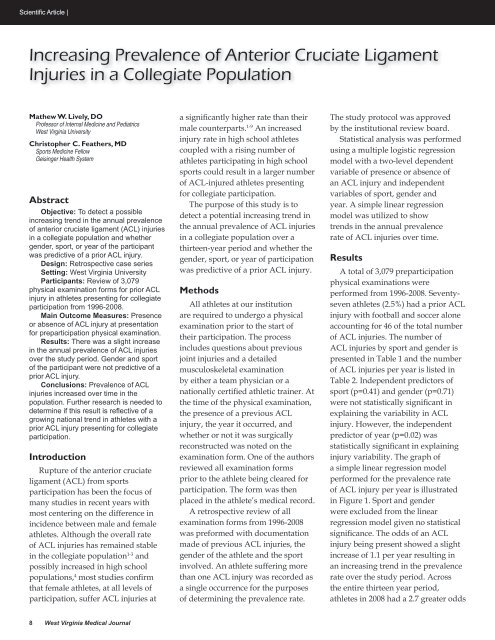Adam E. Klein, MD - West Virginia State Medical Association
Adam E. Klein, MD - West Virginia State Medical Association
Adam E. Klein, MD - West Virginia State Medical Association
You also want an ePaper? Increase the reach of your titles
YUMPU automatically turns print PDFs into web optimized ePapers that Google loves.
Scientific Article |Increasing Prevalence of Anterior Cruciate LigamentInjuries in a Collegiate PopulationMathew W. Lively, DOProfessor of Internal Medicine and Pediatrics<strong>West</strong> <strong>Virginia</strong> UniversityChristopher C. Feathers, <strong>MD</strong>Sports Medicine FellowGeisinger Health SystemAbstractObjective: To detect a possibleincreasing trend in the annual prevalenceof anterior cruciate ligament (ACL) injuriesin a collegiate population and whethergender, sport, or year of the participantwas predictive of a prior ACL injury.Design: Retrospective case seriesSetting: <strong>West</strong> <strong>Virginia</strong> UniversityParticipants: Review of 3,079physical examination forms for prior ACLinjury in athletes presenting for collegiateparticipation from 1996-2008.Main Outcome Measures: Presenceor absence of ACL injury at presentationfor preparticipation physical examination.Results: There was a slight increasein the annual prevalence of ACL injuriesover the study period. Gender and sportof the participant were not predictive of aprior ACL injury.Conclusions: Prevalence of ACLinjuries increased over time in thepopulation. Further research is needed todetermine if this result is reflective of agrowing national trend in athletes with aprior ACL injury presenting for collegiateparticipation.IntroductionRupture of the anterior cruciateligament (ACL) from sportsparticipation has been the focus ofmany studies in recent years withmost centering on the difference inincidence between male and femaleathletes. Although the overall rateof ACL injuries has remained stablein the collegiate population 1-3 andpossibly increased in high schoolpopulations, 4 most studies confirmthat female athletes, at all levels ofparticipation, suffer ACL injuries ata significantly higher rate than theirmale counterparts. 1-9 An increasedinjury rate in high school athletescoupled with a rising number ofathletes participating in high schoolsports could result in a larger numberof ACL-injured athletes presentingfor collegiate participation.The purpose of this study is todetect a potential increasing trend inthe annual prevalence of ACL injuriesin a collegiate population over athirteen-year period and whether thegender, sport, or year of participationwas predictive of a prior ACL injury.MethodsAll athletes at our institutionare required to undergo a physicalexamination prior to the start oftheir participation. The processincludes questions about previousjoint injuries and a detailedmusculoskeletal examinationby either a team physician or anationally certified athletic trainer. Atthe time of the physical examination,the presence of a previous ACLinjury, the year it occurred, andwhether or not it was surgicallyreconstructed was noted on theexamination form. One of the authorsreviewed all examination formsprior to the athlete being cleared forparticipation. The form was thenplaced in the athlete’s medical record.A retrospective review of allexamination forms from 1996-2008was preformed with documentationmade of previous ACL injuries, thegender of the athlete and the sportinvolved. An athlete suffering morethan one ACL injury was recorded asa single occurrence for the purposesof determining the prevalence rate.The study protocol was approvedby the institutional review board.Statistical analysis was performedusing a multiple logistic regressionmodel with a two-level dependentvariable of presence or absence ofan ACL injury and independentvariables of sport, gender andyear. A simple linear regressionmodel was utilized to showtrends in the annual prevalencerate of ACL injuries over time.ResultsA total of 3,079 preparticipationphysical examinations wereperformed from 1996-2008. Seventysevenathletes (2.5%) had a prior ACLinjury with football and soccer aloneaccounting for 46 of the total numberof ACL injuries. The number ofACL injuries by sport and gender ispresented in Table 1 and the numberof ACL injuries per year is listed inTable 2. Independent predictors ofsport (p=0.41) and gender (p=0.71)were not statistically significant inexplaining the variability in ACLinjury. However, the independentpredictor of year (p=0.02) wasstatistically significant in explaininginjury variability. The graph ofa simple linear regression modelperformed for the prevalence rateof ACL injury per year is illustratedin Figure 1. Sport and genderwere excluded from the linearregression model given no statisticalsignificance. The odds of an ACLinjury being present showed a slightincrease of 1.1 per year resulting inan increasing trend in the prevalencerate over the study period. Acrossthe entire thirteen year period,athletes in 2008 had a 2.7 greater odds8 <strong>West</strong> <strong>Virginia</strong> <strong>Medical</strong> Journal















